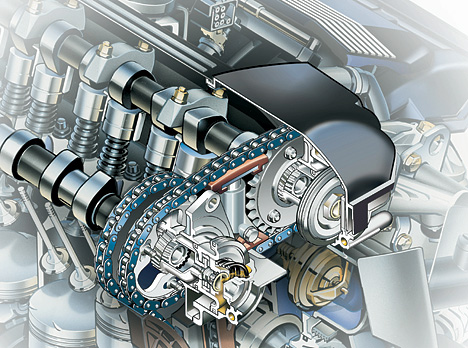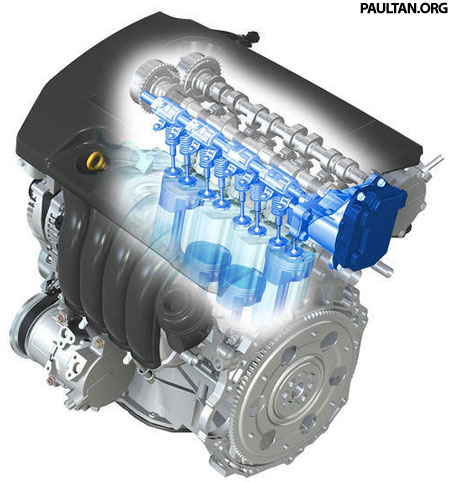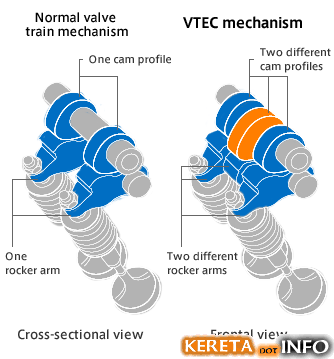The Valvetronic system is the first variable valve timing system to offer continuously variable timing (on both intake and exhaust camshafts) along with continuously variable intake valve lift, from ~0 to 10 mm, on the intake camshaft only. Valvetronic-equipped engines are unique in that they rely on the amount of valve lift to throttle the engine rather than a butterfly valve in the intake tract. In other words, in normal driving, the 'gas pedal' controls the Valvetronic hardware rather than the throttle plate First introduced by BMW on the 316ti compact in 2001, Valvetronic has since been added to many of BMW's engines. The Valvetronic system is coupled with BMW's proven double-VANOS, to further enhance both power and efficiency across the engine speed range. Valvetronic will not be coupled to BMW's N53 and N54, 'High Precision Injection' (gasoline direct injection) technology due to lack of room in the cylinder head. Cylinder heads with Valvetronic use an extra set of rocker arms, called intermediate arms (lift scaler), positioned between the valve stem and the camshaft. These intermediate arms are able to pivot on a central point, by means of an extra, electronicly actuated camshaft. This movement alone, without any movement of the intake camshaft, can open or close the intake valves. Because the intake valves now have the ability to move from fully closed to fully open positions, and everywhere in between, the primary means of engine load control is transferred from the throttle plate to the intake valvetrain. By eliminating the throttle plate's 'bottleneck' in the intake track, pumping losses are reduced, fuel economy and responsiveness are improved.
Saturday, March 14, 2009
Valvetronic
VANOS (Variable Nockenwellen Steuerung)

Ball Valve
A ball valve (like the butterfly valve, one of a family of valves called quarter turn valves) is a valve that opens by turning a handle attached to a ball inside the valve. The ball has a hole, or port, through the middle so that when the port is in line with both ends of the valve, flow will occur. When the valve is closed, the hole is perpendicular to the ends of the valve, and flow is blocked. The handle position lets you 'see' the valve's position.
Ball valves are durable and usually work to achieve perfect shutoff even after years of disuse. They are therefore an excellent choice for shutoff applications (and are often preferred to globe valves and gate valves for this purpose). They do not offer the fine control that may be necessary in throttling applications but are sometimes used for this purpose.
The body of ball valves may be made of metal, ceramic, or plastic. The ball may be chrome plated to make it more durable.
There are three general types of ball valves: full port, standard port, and reduced port.

- A full port ball valve has an oversized ball so that the hole in the ball is the same size as the pipeline resulting in lower friction loss. Flow is unrestricted, but the valve is larger.
- A standard port ball valve is usually less expensive, but has a smaller ball and a correspondingly smaller port. Flow through this valve is one pipe size smaller than the valve's pipe size resulting in slightly restricted flow.
- In reduced port ball valves, flow through the valve is two pipe sizes smaller than the valve's pipe size resulting in restricted flow.

Gate Valve
A gate valve is a valve that opens by lifting a round or rectangular gate out of the path of the fluid. The distinct feature of a gate valve is the sealing surfaces between the gate and seats are planar. The gate faces can form a wedge shape or they can be parallel. Gate valves are sometimes used for regulating flow, but many are not suited for that purpose, having been designed to be fully opened or closed. When fully open, the typical gate valve has no obstruction in the flow path, resulting in very low friction loss. Bonnets provide leakproof closure for the valve body. Gate valves may have a screw-in, union, or bolted bonnet. Screw-in bonnet is the simplest, offering a durable, pressure-tight seal. Union bonnet is suitable for applications requiring frequent inspection and cleaning. It also gives the body added strength. Bolted bonnet is used for larger valves and higher pressure applications. Another type of bonnet construction in a gate valve is pressure seal bonnet. This construction is adopted for valves for high pressure service, typically in excess of 2250 psi. The unique feature about the pressure seal bonnet is that the body - bonnet joints seals improves as the internal pressure in the valve increases, compared to other constructions where the increase in internal pressure tends to create leaks in the body-bonnet joint.
Gate valves are characterised as having either a rising or a nonrising stem. Rising stems provide a visual indication of valve position. Nonrising stems are used where vertical space is limited or underground.
Globe valves
Globe valves are named for their spherical body shape. The two halves of the valve body are separated by a baffle with a disc in the center. Globe valves operate by screw action of the handwheel. They are used for applications requiring throttling and frequent operation. Since the baffle restricts flow, they're not recommended where full, unobstructed flow is required. A bonnet provides leakproof closure for the valve body. Globe valves may have a screw-in, union, or bolted bonnet. Screw-in bonnet is the simplest bonnet, offering a durable, pressure-tight seal. Union bonnet is suitable for applications requiring frequent inspection or cleaning. It also gives the body added strength. Bolted bonnet is used for larger or higher pressure applications. Many globe valves have a class rating that corresponds to the pressure specifications of ANSI 16.34. Other different types of valve usually are called globe style valves because of the shape of the body or the way of closure of the disk. As an example typical swing check valves could be called globe type.
VVT-i
VVT-i, or Variable Valve Timing with intelligence, is an automobile variable valve timing technology developed by Toyota. The Toyota VVT-i system replaces the Toyota VVT offered starting in 1991 on the 4A-GE 20-Valve engine. The VVT system is a 2-stage hydraulically controlled cam phasing system. VVT-i, introduced in 1996, varies the timing of the intake valves by adjusting the relationship between the camshaft drive (belt, scissor-gear or chain) and intake camshaft. Engine oil pressure is applied to an actuator to adjust the camshaft position. In 1998, 'Dual' VVT-i (adjusts both intake and exhaust camshafts) was first introduced in the RS200 Altezza's 3S-GE engine. Dual VVT-i is also found in Toyota's new generation V6 engine, the 3.5L 2GR-FE V6. This engine can be found in the Avalon, RAV4, and Camry in the US, the Aurion in Australia, and various models in Japan, including the Estima. Other Dual VVT-i engines will be seen in upcoming Toyota models, including a new 4 cylinder Dual VVT-i engine for the new generation 2007/2008 Corolla. Another notable implementation of the Dual VVT-i is the 2GR-FSE D-4S engine of the Lexus GS450h. By adjusting the valve timing, engine start and stop occur virtually unnoticable at minimum compression, and fast heating of the catalytic converter to its light-off temperature is possible, thereby reducing HC emissions considerably.
VTEC
VTEC was initially designed to increase the power output of an engine to 100 ps/liter or more while maintaining practicality for use in mass production vehicles. Some later variations of the system were designed solely to provide improvements in fuel efficiency, or increased power output as well as improved fuel efficiency.
